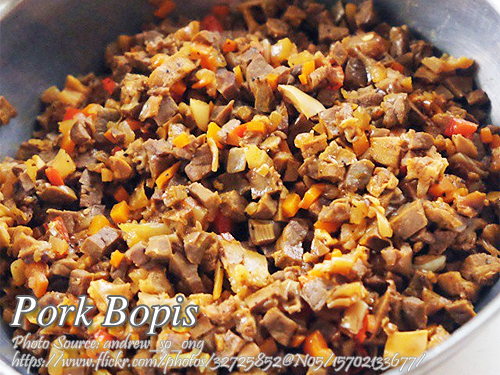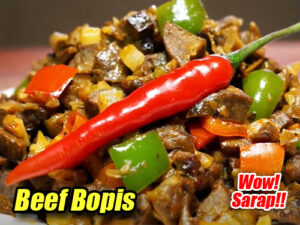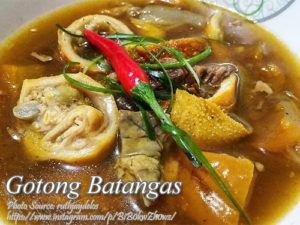Bopis is a popular Filipino spicy dish made with pig’s innards like heart and lungs. It is great to serve as an appetizer or main dish, as a mouth watering viand served with cooked rice. The process of cooking this dish is simple but don’t forget to wash and boil the pig’s lungs in water and vinegar since there is a strong odor and offal taste if you will not include vinegar. Some use lemongrass but I think vinegar is the best for removing or minimizing the odor. Depending on your preference, you can cook this bopis dry or with a little sauce. Personally prefer the dry bopis because it masks the pungent odor of the lungs and sometimes I can taste it a little slimy when it has sauce.
A Flavorful Filipino Favorite
Pork Bopis is a delightful Filipino dish that combines savory and spicy flavors with a slightly tangy undertone. Known for its unique use of pork innards, particularly the heart and lungs, this recipe is a common fixture in Filipino kitchens, often served as an appetizer or main course alongside warm, fluffy rice. While the idea of using offal might seem unconventional to some, the dish transforms these humble ingredients into a flavorful experience, especially when cooked with a balance of vinegar and spices.
The Origins of Bopis: A Dish with Depth
Bopis has deep roots in Filipino cuisine, with its origins believed to date back to the Spanish colonial era. Its name is thought to come from the Spanish word “bofes,” which refers to the lungs. Like many Filipino dishes, this recipe showcases how Filipinos maximize every part of the animal, a testament to the resourcefulness ingrained in the country’s food culture. Though traditionally made with pork offal, variations of bopis can be found using other meats like chicken or beef, depending on regional preferences.
Today, Bopis remains a favorite in many Filipino households, often enjoyed during casual gatherings, celebrations, or even as pulutan (food served with alcoholic drinks). Its bold, spicy flavor profile makes it perfect for those who crave something with a bit of heat and a rich umami kick.
Prepping the Ingredients: An Essential Step
The key to a delicious bopis lies in its preparation. Since pork offal has a strong, pungent odor, properly cleaning the heart and lungs is essential to remove any unpleasant taste. Rinsing the organs under running water ensures that excess blood and impurities are washed away. However, it’s the step of boiling them with vinegar and salt that truly neutralizes any lingering odors. Vinegar not only helps in tenderizing the meat but also serves to minimize the strong offal flavor, making the dish more palatable.
Though some cooks might opt to use lemongrass for a fresher scent, vinegar remains the more traditional and effective method. After boiling, the organs are chopped finely into small cubes. This helps the innards absorb the flavorful seasoning and sauce better, creating that mouthwatering blend of textures and tastes.
Building the Flavor: Sauteing and Seasoning
After prepping the innards, the next step is to bring the flavors together through sauteing. This process begins by heating oil and lightly frying garlic and onions until they release their aroma, signaling the perfect time to add in the heart and lungs. The initial saute not only infuses the meat with the fragrance of the aromatics but also begins layering the flavors that make the dish stand out.
Once the meat is well-coated with the garlic and onions, the addition of chili powder and laurel leaves imparts that signature spice and earthiness to the dish. This is followed by a medley of vegetables like carrots, radish, and bell peppers, which add a subtle sweetness and crunch. These vegetables aren’t just for added texture—they provide a balance to the intense flavors of the offal, creating a more well-rounded dish.
Achieving the Perfect Sauce
One of the most debated aspects of this dish is its consistency. Some prefer it dry, while others enjoy a little sauce in their bopis. A splash of vinegar and soup stock helps to create a sauce that can either be cooked down until nearly dry or left with a bit of liquid, depending on your preference. The vinegar continues to work its magic by breaking down the rich flavors of the innards and brightening the dish with its acidity.
For a deeper color and flavor, annatto water is added at this stage. Annatto, derived from the seeds of the achiote tree, gives the dish a warm, reddish hue and a subtle peppery flavor, making the presentation just as appealing as the taste.
Final Touches: Seasoning and Serving
To round off the cooking process, the dish is seasoned with patis (fish sauce) and black pepper. These ingredients add depth, enhancing the savory notes and tying together the overall flavor profile. Once the bopis has simmered and all the ingredients are well-incorporated, the dish is ready to serve.
Though often enjoyed with steamed rice, the bold flavors make this dish versatile enough to be paired with a variety of sides. Some even serve it with a cold beer, making it a popular choice for gatherings and casual parties.
A Note on Variations
Like many traditional Filipino dishes, bopis varies from region to region and household to household. Some cooks like to add more vegetables, such as tomatoes or green chilies, to amp up the flavor and texture. Others might tweak the amount of vinegar or spice to suit their personal taste. The beauty of this dish lies in its versatility, allowing cooks to adapt it to their preferences while staying true to its roots.
Bopis: More Than Just a Dish
Though it may be simple in its ingredients, bopis is more than just a meal. It’s a reflection of Filipino ingenuity, a dish born from making the most of what’s available and turning it into something truly delicious. Whether you’re a seasoned cook or a beginner looking to explore the flavors of Filipino cuisine, bopis offers an exciting, flavorful adventure that will surely satisfy your taste buds.
So next time you’re in the mood for something bold and flavorful, consider trying this recipe. With the right balance of spices, vegetables, and perfectly cooked pork innards, you’re sure to create a dish that’s rich in history and bursting with flavor.
How to Cook Pork Bopis
Ingredients
- 2 pcs pork heart
- 1/2 kilo pork lungs
- 1/4 kilo pork fat
- 7 cloves garlic minced
- 1 large red onion minced
- 4 pcs laurel leaves
- 2 red and green bell peppers finely diced
- 1 pc carrot diced finely
- 1 pc radish diced finely
- 2 cups vinegar
- 1 cup soup stock from boiled pork heart/lungs
- 1 Tbsp. chili powder or chopped siling labuyo
- 1 Tbsp. annatto powder dissolved in 2 Tbsp hot water
- cooking oil
- patis to taste
- salt to taste
- ground black pepper to taste
Instructions
How to cook pork bopis:
- Wash the pork heart and pork lungs thoroughly in running water. In a large pot, put the pork heart and lungs and pour water just enough to cover the pork innards. Add a cup of vinegar and one tablespoon salt.
- Bring to a boil and cook for 25 minutes or until tender. Remove from the broth and drain. Cool and dice finely or chop into small cubes. Set aside.
- Heat oil in a medium size wok or cooking pan, saute garlic and onion until fragrant. Add in the pork heart and lungs and saute for about 3 minutes. Season with chili powder and laurel leaves.
- Add in the carrot, radish, bell peppers and stir. Pour one cup of vinegar and soup stock then bring to a boil. Cook until the liquid evaporates and almost dry. But you can leave some liquid if you prefer the bopis with sauce.
- Pour the annato water and season with patis and black pepper. Stir and simmer for a minute more then turn off heat. Serve hot with cooked rice and enjoy!
Notes
Cooking Tips:
Properly Clean the Pork Innards
Before cooking, make sure to thoroughly wash the pork heart and lungs under running water to remove impurities. Boil the innards with vinegar and salt to neutralize any strong odors and to tenderize the meat. This step is crucial to achieve a cleaner, more pleasant flavor in the finished dish.Finely Chop for Better Flavor Absorption
Dicing the innards into small, uniform pieces allows them to absorb the seasoning and spices more effectively. Smaller pieces also cook evenly and mix well with the vegetables, creating a harmonious blend of textures. This ensures that each bite is packed with flavor and has a consistent texture.Adjust the Sauce to Your Preference
Whether you like your bopis dry or with a bit of sauce, control the liquid by adjusting the cooking time. If you prefer a drier version, cook until the liquid has mostly evaporated, leaving just a hint of sauce. For a saucier dish, reduce the heat early and allow some liquid to remain for a richer, more indulgent meal.






hi. how much is 1 serving? 1 cup? 1 bowl? grams?
Hi Rey, yes I think it is 1 cup.